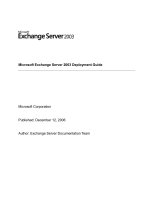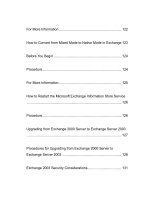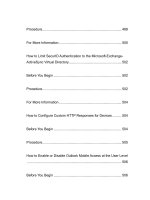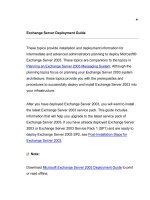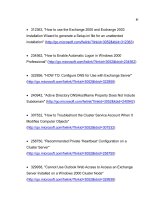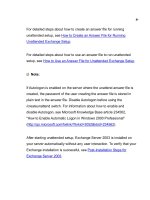Microsoft Exchange Server 2003 Deployment Guide- P42 docx
Bạn đang xem bản rút gọn của tài liệu. Xem và tải ngay bản đầy đủ của tài liệu tại đây (228.79 KB, 10 trang )
411
How to Create an HTTP Virtual Server Resource for an Exchange
Virtual Server in a Windows Server Cluster
For the Cluster service to manage each HTTP virtual server, you must
create a new HTTP server resource for each HTTP virtual server. This
topic explains how to create an HTTP virtual server resource for an
Exchange Virtual Server in a Windows Server cluster.
Before You Begin
You must perform the following steps for each Exchange Virtual Server to
which you have added a new HTTP virtual server.
Procedure
To create an HTTP virtual server resource for an Exchange Virtual
Server in a Windows Server cluster
1. Open Cluster Administrator.
2. Right-click the Exchange Virtual Server, point to New, and then
click Resource.
412
3. The New Resource Wizard starts. In the Name box, type E
xchange
HTTP Virtual Server - (<EVSName>), where EVSName is the name
of the front-end server.
4. In the Resource type list, click Microsoft Exchange HTTP Server
Instance. Verify that the Group list contains the name of your
Exchange Virtual Server, and then click Next.
5. In Possible Owners, under Possible owners, verify that all nodes
are displayed, and then click Next.
6. In Dependencies, add the Exchange System Attendant resource
to the Resource dependencies box, and then click Next.
7. In Virtual Server Instance, in the Server Instance list, select the
newly created HTTP virtual server for the resource, and then click
Finish.
8. In Cluster Administrator, right-click the HTTP virtual server
instances you just created, and then click Bring Online.
413
How to Create Virtual Directories for an Exchange Virtual Server in a
Windows Server Cluster
When you create an Exchange Virtual Server, during the creation of the
Exchange System Attendant resource, Exchange creates an HTTP virtual
server resource. This topic explains how to create virtual directories for
an Exchange Virtual Server in a Windows Server cluster.
Before you can create a virtual directory, you must create an HTTP virtual
server in Exchange System Manager. For detailed instructions, see How
to Create an HTTP Virtual Server in Exchange System Manager. After
you create the HTTP virtual server, you must add virtual directories to the
back-end server(s) that match the virtual directories configured on the
front-end server. A typical Exchange installation contains virtual
directories called Exchange and Public. In Exchange System Manager,
virtual directories of HTTP virtual servers appear as child objects of the
HTTP virtual server.
Before You Begin
For any virtual directories that point to mailboxes, ensure that the SMTP
domain selected on the virtual directory Properties matches the SMTP
domain of users who will be using that front-end server. If the correct
domain is not selected, users of that domain will not be able to use that
414
virtual server to log on. The list of domains is compiled from the domains
of the SMTP addresses in the Exchange organization's recipient policies.
If you have more than one recipient policy for the same domain, you will
see duplicates. In this case, it does not matter which one you select.
Procedure
To create virtual directories for an Exchange Virtual Server in a
Windows Server cluster
1. Open Exchange System Manager
2. In the console tree, expand Servers, expand the server that you
want to configure as a back-end server, expand Protocols, and then
expand HTTP.
3. Right-click <HTTP Virtual Server Name>, point to New, and then
click Virtual Directory.
4. In Properties, in the Name box, type Exchange.
5. Under Exchange Path, the Mailboxes for SMTP domain option is
selected by default. Keep this setting, because users use the
415
Exchange virtual directory to access their Exchange mailboxes. Click
OK to create the first virtual directory.
6. In the console tree, right-click <HTTP Virtual Server Name>
again,
point to New, and then click Virtual Directory.
7. In Properties, in the Name box, type Public.
8. Under Exchange Path, click Public folder, and then click Modify.
9. In Public Folder Selection, double-click Public Folders. After a
few seconds, Exchange resolves the public folder's server name and
appends it to the name of the Public Folders container.
The Public Folder Selection dialog box
416
10. Click OK to close the Public Folder Selection dialog box.
11. In Properties, click OK.
12. If there are additional virtual directories configured on your front-
end server, you must also create those virtual directories. To create
additional virtual directories, repeat Steps 5 through 10 for each virtual
directory.
417
For More Information
For more information about creating virtual directories, see "Configure the
Server's Virtual Directory" in Exchange 2003 Help.
How to Upgrade an Exchange 2000 Cluster to Exchange Server 2003
Upgrading an Exchange 2000 cluster to Exchange 2003 requires that you
upgrade each of the cluster nodes and Exchange Virtual Servers to
Exchange 2003.
Before You Begin
Before you perform the procedures in this topic, be aware of the
following:
After you upgrade to Exchange Server 2003, the cluster service
account no longer needs any Exchange-specific permissions. To follow
the common security practice known as least privilege, you should
remove the Exchange-specific permissions you assigned during the
upgrade after the last Exchange 2000 cluster has been upgraded or
migrated to Exchange Server 2003.
418
You need to perform this procedure only once per cluster.
Procedure
To perform a rolling upgrade of an Exchange 2000 cluster to
Exchange Server 2003
1. Upgrade each node in the cluster to Exchange Server 2003. For
detailed steps, see How to Perform a Rolling Upgrade of an Exchange
2000 Cluster to Exchange Server 2003.
2. Remove the Exchange permissions for the cluster service account.
For detailed steps, see How to Remove Cluster Service Account
Exchange Permissions After Upgrading from Exchange 2000 to
Exchange Server 2003.
To perform a clean upgrade of an Exchange 2000 cluster to
Exchange Server 2003
1. Evict each node, one at a time, and build the evicted nodes as new
clusters. For detailed steps, see How to Perform a Clean Upgrade of
an Exchange 2000 Cluster to Exchange Server 2003.
419
2. Remove the Exchange permissions for the cluster service account.
For detailed steps, see How to Remove Cluster Service Account
Exchange Permissions After Upgrading from Exchange 2000 to
Exchange Server 2003.
How to Perform a Rolling Upgrade of an Exchange 2000 Cluster to
Exchange Server 2003
To perform a rolling upgrade of an Exchange 2000 cluster to Exchange
2003, you must first run Exchange 2003 Setup to upgrade the nodes of
your cluster, and then use Cluster Administrator to upgrade the Exchange
Virtual Servers.
Before You Begin
Before you perform the procedure in this topic, consider the following:
It is recommended that you upgrade one Exchange cluster node at a
time.
420
When upgrading each node, it is recommended that you move the
Exchange Virtual Server from the node you are upgrading to another
node. This enables users to access their e-mail through the relocated
Exchange Virtual Server during the Exchange 2003 upgrade process.
This procedure uses the following upgrade scenario for example
purposes.
Upgrading an Exchange 2000 SP3 cluster with four nodes (Node 1,
Node 2, Node 3, and Node 4) and three Exchange Virtual Servers (EVS1,
EVS2, and EVS3). EVS1 is running on Node 1, EVS2 is running on Node
2, and EVS3 is running on Node 3. Node 4 is the standby node.
Note:
If your cluster topology is different than the one in this example, modify
the following steps as necessary.
